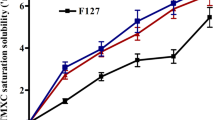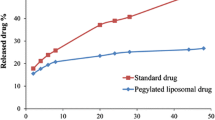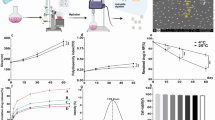Abstract
Serious adverse effects and low selectivity to cancer cells are the main obstacles of long term therapy with Tamoxifen (Tmx). This study aimed to develop Tmx-loaded span-based nano-vesicles for delivery to malignant tissues with maximum efficacy. The effect of three variables on vesicle size (Y1), zeta potential (Y2), entrapment efficiency (Y3) and the cumulative percent release after 24 h (Y4) were optimized using Box-Behnken design. The optimized formula was prepared and tested for its stability in different storage conditions. The observed values for the optimized formula were 310.2 nm, − 42.09 mV, 75.45 and 71.70% for Y1, Y2, Y3, and Y4, respectively. The examination using electron microscopy confirmed the formation of rounded vesicles with distinctive bilayer structure. Moreover, the cytotoxic activity of the optimized formula on both breast cancer cells (MCF-7) and normal cells (BHK) showed enhanced selectivity (9.4 folds) on cancerous cells with IC50 values 4.7 ± 1.5 and 44.3 ± 1.3 μg/ml on cancer and normal cells, respectively. While, free Tmx exhibited lower selectivity (2.5 folds) than optimized nano-vesicles on cancer cells with IC50 values of 9.0 ± 1.1 μg/ml and 22.5 ± 5.3 μg/ml on MCF-7 and BHK cells, respectively. The promising prepared vesicular system, with greater efficacy and selectivity, provides a marvelous tool to overcome breast cancer treatment challenges.





Similar content being viewed by others
References
Jemal A, Siegel R, Ward E, Hao Y, Xu J, Murray T, et al. Cancer statistics, 2008. CA Cancer J Clin [Internet]. 2008;58(2):71–96. Available from: http://doi.wiley.com/10.3322/CA.2007.0010.
Torre LA, Bray F, Siegel RL, Ferlay J, Lortet-tieulent J, Jemal A. Global cancer statistics, 2012. CA Cancer J Clin. 2015;65(2):87–108. https://doi.org/10.3322/caac.21262.
Ferlay J, Soerjomataram I, Dikshit R, Eser S, Mathers C, Rebelo M, et al. Cancer incidence and mortality worldwide: sources, methods and major patterns in GLOBOCAN 2012. Int J Cancer. 2015;136(5):E359–86. https://doi.org/10.1002/ijc.29210.
Lukong KE. Understanding breast cancer – the long and winding road. BBA Clin. 2017;7:64–77. https://doi.org/10.1016/j.bbacli.2017.01.001.
Pandey SK, Ghosh S, Maiti P, Haldar C. Therapeutic efficacy and toxicity of tamoxifen loaded PLA nanoparticles for breast cancer. Int J Biol Macromol. 2015;72:309–19. https://doi.org/10.1016/j.ijbiomac.2014.08.012. Elsevier BV.
Au JS, Jang SH, Zheng J, Chen CT, Song S, Hu L, et al. Determinants of drug delivery and transport to solid tumors. J Control Release. 2001;74(1–3):31–46. https://doi.org/10.1016/S0168-3659(01)00308-X.
Murray AJ, Davies DM. The genetics of breast cancer. Surgery (United Kingdom). 2013;31(1):1–3. Elsevier Ltd.
Altmeyer C, Karam TK, Khalil NM, Mainardes RM. Tamoxifen-loaded poly(L-lactide) nanoparticles: development, characterization and in vitro evaluation of cytotoxicity. Mater Sci Eng C. 2016;60:135–42. https://doi.org/10.1016/j.msec.2015.11.019. Elsevier BV.
Radin DP, Patel P. Delineating the molecular mechanisms of tamoxifen’s oncolytic actions in estrogen receptor-negative cancers. Eur J Pharmacol. 2016;781:173–80. https://doi.org/10.1016/j.ejphar.2016.04.017. Elsevier.
Spears M, Bartlett J. The potential role of estrogen receptors and the SRC family as targets for the treatment of breast cancer. Expert Opin Ther Targets. 2009;13(6):665–74. https://doi.org/10.1517/14728220902911509.
Jordan VC. Tamoxifen (ICI46,474) as a targeted therapy to treat and prevent breast cancer. Br J Pharmacol. 2006;147(Suppl 1):S269–76.
Barron AJ, Zaman N, Cole GD, Wensel R, Okonko DO, Francis DP. Systematic review of genuine versus spurious side-effects of beta-blockers in heart failure using placebo control: recommendations for patient information. Int J Cardiol [Internet]. Elsevier; 2013 Oct 9 [cited 2017 Apr 16];168(4):3572–9. Available from: http://www.ncbi.nlm.nih.gov/pubmed/23796325.
Kouchakzadeh H, Shojaosadati SA, Shokri F. Efficient loading and entrapment of tamoxifen in human serum albumin based nanoparticulate delivery system by a modified desolvation technique. Chem Eng Res Des. 2014;92(9):1681–92. Institution of Chemical Engineers
Mugundu GM, Sallans L, Guo Y, Shaughnessy EA, Desai PB. Assessment of the impact of CYP3A polymorphisms on the formation of alpha hydroxytamoxifen and N-desmethyltamoxifen in human liver microsomes. Drug Metab Dispos. 2012;40(2):389–96. https://doi.org/10.1124/dmd.111.039388.
Zembutsu H. Pharmacogenomics toward personalized tamoxifen therapy for breast cancer. Pharmacogenomics. 2015;16(3):287–96. https://doi.org/10.2217/pgs.14.171.
Stevens DM, Gilmore KA, Harth E. An assessment of nanosponges for intravenous and oral drug delivery of BCS class IV drugs: drug delivery kinetics and solubilization. Polym Chem. 2014;5(11):3551–4.
Lockhart JN, Stevens DM, Beezer DB, Kravitz A, Harth E. Dual drug delivery of tamoxifen and quercetin: Regulated metabolism for anticancer treatment with nanosponges. J Control Release. 2015;220:751–7. Elsevier B.V.
Lee MH, Kim JW, Kim JH, Kang KS, Kong G, Lee MO. Gene expression profiling of murine hepatic steatosis induced by tamoxifen. Toxicol Lett. 2010;199(3):416–24. https://doi.org/10.1016/j.toxlet.2010.10.008. Elsevier Ireland Ltd.
Davis ME, Chen Z, Shin DM. Nanoparticle therapeutics: an emerging treatment modality for cancer. Nat Rev Drug Discov. 2008;7(9):771–82. https://doi.org/10.1038/nrd2614.
Xin Y, Huang Q, Tang JQ, Hou XY, Zhang P, Zhang LZ, et al. Nanoscale drug delivery for targeted chemotherapy. Cancer Lett. 2016;379(1):24–31. https://doi.org/10.1016/j.canlet.2016.05.023. Elsevier Ireland Ltd.
Panzarini E, Inguscio V, Tenuzzo B, Carata E, Dini L. Nanomaterials and autophagy: new insights in cancer treatment. Cancers (Basel). 2013;5(1):296–319. https://doi.org/10.3390/cancers5010296.
Bansal D, Gulbake A, Tiwari J, Jain SK. Development of liposomes entrapped in alginate beads for the treatment of colorectal cancer. Int J Biol Macromol. 2016;82:687–95. https://doi.org/10.1016/j.ijbiomac.2015.09.052. Elsevier B.V.
Jeong K, Kang CS, Kim Y, Lee Y-D, Kwon IC, Kim S. Development of highly efficient nanocarrier-mediated delivery approaches for cancer therapy. Cancer Lett. 2016;374(1):31–43. https://doi.org/10.1016/j.canlet.2016.01.050. Elsevier Ireland Ltd.
Kemp JA, Shim MS, Heo CY, Kwon YJ. “Combo” nanomedicine: co-delivery of multi-modal therapeutics for efficient, targeted, and safe cancer therapy. Adv Drug Deliv Rev. Elsevier B.V. 2016;98:3–18.
Patel P, Agrawal YK. Targeting nanocarriers containing antisense oligonucleotides to cancer cell. J Drug Deliv Sci Technol. 2017;37:97–114. https://doi.org/10.1016/j.jddst.2016.12.001. Elsevier Ltd.
Ghanbarzadeh S, Khorrami A, Arami S. Nonionic surfactant-based vesicular system for transdermal drug delivery. Drug Deliv. 2014;7544:1–7.
Marianecci C, Di Marzio L, Rinaldi F, Celia C, Paolino D, Alhaique F, et al. Niosomes from 80s to present: the state of the art. Adv Colloid Interface Sci [Internet]. 2014 Mar [cited 2014 Nov 27];205:187–206. Available from: http://www.ncbi.nlm.nih.gov/pubmed/24369107.
Bayindir ZS, Yuksel N. Characterization of niosomes pepared with various nonionic surfactants for paclitaxel oral delivery. J Pharm Technol 2010;99(4):2049–60. Available from: http://www.ncbi.nlm.nih.gov/pubmed/19780133.
Shilpa S, Srinivasan BP, Chauhan M. Niosomes as vesicular carriers for delivery of proteins and biologicals. Int J Drug Deliv. 2011;3(1):14–24. https://doi.org/10.5138/ijdd.2010.0975.0215.03050.
Bragagni M, Mennini N, Furlanetto S, Orlandini S, Ghelardini C, Mura P. Development and characterization of functionalized niosomes for brain targeting of dynorphin-B. Eur J Pharm Biopharm. 2014;87(1):73–9. https://doi.org/10.1016/j.ejpb.2014.01.006. Elsevier BV.
Marianecci C, Di Marzio L, Del Favero E, Cantu L, Brocca P, Rondelli V, et al. Niosomes as drug nanovectors: multiscale pH-dependent structural response. Langmuir. 2016;32(5):1241–9. https://doi.org/10.1021/acs.langmuir.5b04111.
Khoee S, Yaghoobian M. Niosomes: a novel approach in modern drug delivery systems. Nanostructures for Drug Delivery. Elsevier Inc.; 2017. p. 207-237. https://doi.org/10.1016/B978-0-323-46143-6.00006-3.
Hao Y, Zhao F, Li N, Yang Y, Li K. Studies on a high encapsulation of colchicine by a niosome system. Int J Pharm [Internet]. 2002 Sep [cited 2014 Dec 11];244 (1–2):73–80. Available from: http://www.sciencedirect.com/science/article/pii/S0378517302003010.
Manosroi A, Wongtrakul P, Manosroi J, Sakai H, Sugawara F, Yuasa M, et al. Characterization of vesicles prepared with various non-ionic surfactants mixed with cholesterol. Colloids Surfaces B Biointerfaces [Internet]. 2003 Jul [cited 2014 Nov 12];30 (1–2):129–38. Available from: http://www.sciencedirect.com/science/article/pii/S0927776503000808.
Yeom S, Shin BS, Han S. An electron spin resonance study of non-ionic surfactant vesicles (niosomes). Chem Phys Lipids. 2014;181:83–9. https://doi.org/10.1016/j.chemphyslip.2014.03.004. Elsevier Ireland Ltd.
Yoshioka T, Sternberg B, Florence AT. Preparation and properties of vesicles (niosomes) of sobitan monoesters (Span 20, 40, 60, 80) and a sorbitan triester (Span 85). Int J Pharm. 1994;105:1–6.
El-Say KMKM, Abd-Allah FI, Lila AE, Hassan AE-SA, Kassem AEA. Diacerein niosomal gel for topical delivery: development, in vitro and in vivo assessment. J Liposome Res [Internet]. 2016;26(1):57–68. Available from: http://informahealthcare.com/doi/abs/10.3109/08982104.2015.1029495.
Kassem MA, El-Sawy HS, Abd-Allah FI, Abdelghany TM, El-Say KM. Maximizing the therapeutic efficacy of imatinib mesylate–loaded niosomes on human colon adenocarcinoma using Box-Behnken design. J Pharm Sci. 2017;106(1):111–22. https://doi.org/10.1016/j.xphs.2016.07.007.
El-Ridy MS, Abdelbary A, Essam T, Abd EL-Salam RM, Aly Kassem AA, El-Salam RMA, et al. Niosomes as a potential drug delivery system for increasing the efficacy and safety of nystatin. Drug Dev Ind Pharm [Internet]. 2011 Dec 27 [cited 2017 Oct 13];37 (12):1491–508. Available from: http://www.ncbi.nlm.nih.gov/pubmed/21707323.
Attia IA, El-Gizawy SA, Fouda MA, Donia AM. Influence of a niosomal formulation on the oral bioavailability of acyclovir in rabbits. AAPS PharmSciTech. 2007;8(4):E106. https://doi.org/10.1208/pt0804106.
Arafa MG, Ayoub BM. DOE optimization of nano-based carrier of pregabalin as hydrogel: new therapeutic & chemometric approaches for controlled drug delivery systems. Sci Rep. 2017;7(January):41503. Nature Publishing Group.
Mokhtar M, Sammour OA, Hammad MA, Megrab NA. Effect of some formulation parameters on flurbiprofen encapsulation and release rates of niosomes prepared from proniosomes. Int J Pharm [Internet]. 2008 [cited 2014 Feb 11];361 (1–2):104–11. Available from: http://www.ncbi.nlm.nih.gov/pubmed/18577437.
Li Y, Zhao X, Zu Y, Zhang Y. Preparation and characterization of paclitaxel nanosuspension using novel emulsification method by combining high speed homogenizer and high pressure homogenization. Int J Pharm. 2015;490(1):324–33. https://doi.org/10.1016/j.ijpharm.2015.05.070.
Ahmed TA, El-Say KM, Aljaeid BM, Fahmy UA, Abd-Allah FI. Transdermal glimepiride delivery system based on optimized ethosomal nano-vesicles: preparation, characterization, in vitro,ex vivo and clinical evaluation. Int Joumal Pharm [Internet]. Elsevier B.V.; 2016; 500 (1–2):245–54. Available from: http://linkinghub.elsevier.com/retrieve/pii/S0378517316300187.
Paolino D, Cosco D, Muzzalupo R, Trapasso E, Picci N, Fresta M. Innovative bola-surfactant niosomes as topical delivery systems of 5-fluorouracil for the treatment of skin cancer. Int J Pharm. 2008;353(1–2):233–42.
Mahmoudi Z, Upadhye S, Ferrizzi D, Rajabi-Siahboomi A. In vitro characterization of a novel polymeric system for preparation of amorphous solid drug dispersions. AAPS J. 2014;16(4):685–97. https://doi.org/10.1208/s12248-014-9590-y.
Shaker DS, Shaker MA, Hanafy MS. Cellular uptake, cytotoxicity and in-vivo evaluation of tamoxifen citrate loaded niosomes. Int J Pharm. 2015;493(1–2):285–94.
Danhier F, Lecouturier N, Vroman B, Jérôme C, Marchand-Brynaert J, Feron O, et al. Paclitaxel-loaded PEGylated PLGA-based nanoparticles: in vitro and in vivo evaluation. J Control Release. 2009;133(1):11–7. https://doi.org/10.1016/j.jconrel.2008.09.086. Elsevier BV.
Mulik RS, Mönkkönen J, Juvonen RO, Mahadik KR, Paradkar AR. ApoE3 mediated polymeric nanoparticles containing curcumin: apoptosis induced in vitro anticancer activity against neuroblastoma cells. Int J Pharm. 2012;437(1–2):29–41. Elsevier B.V.
El-Nabarawi MA, Bendas ER, El Rehem RTA, Abary MYS. Transdermal drug delivery of paroxetine through lipid-vesicular formulation to augment its bioavailability. Int J Pharm. 2013;443(1–2):307–17. Elsevier B.V.
Thakur V, Kush P, Pandey RS, Jain UK, Chandra R, Madan J. Vincristine sulfate loaded dextran microspheres amalgamated with thermosensitive gel offered sustained release and enhanced cytotoxicity in THP-1, human leukemia cells: in vitro and in vivo study. Mater Sci Eng C. 2016;61:113–22. https://doi.org/10.1016/j.msec.2015.12.015. Elsevier B.V.
Qadir A, Faiyazuddin MD, Talib Hussain MD, Alshammari TM, Shakeel F. Critical steps and energetics involved in a successful development of a stable nanoemulsion. J Mol Liq. 2016;214:7–18. https://doi.org/10.1016/j.molliq.2015.11.050. Elsevier BV.
Manconi M, Sinico C, Valenti D, Lai F, Fadda AM. Niosomes as carriers for tretinoin: III. A study into the in vitro cutaneous delivery of vesicle-incorporated tretinoin. Int J Pharm. 2006;311(1–2):11–9.
El-Ridy MS, AA AER, Awad GM, Khalil RM, Younis MM. In-vitro and in-vivo evaluation of niosomes containing celecoxib. Int J Pharm Sci Res. 2014;5(11):4677–88.
Ertekin ZC, Bayindir ZS, Yuksel N. Stability studies on piroxicam encapsulated niosomes. Curr Drug Deliv. 2015;12(2):192–9. https://doi.org/10.2174/1567201811666140723115852.
Zhang Y, Zhang K, Wu Z, Guo T, Ye B, Lu M, et al. Evaluation of transdermal salidroside delivery using niosomes via in vitro cellular uptake. Int J Pharm. 2015;478(1):138–46. https://doi.org/10.1016/j.ijpharm.2014.11.018. Elsevier BV.
Mosmann T. Rapid colorimetric assay for cellular growth and survival: application to proliferation and cytotoxicity assays. J Immunol Methods. 1983;65(1–2):55–63. https://doi.org/10.1016/0022-1759(83)90303-4.
Scudiero DA, Shoemaker RH, Paull KD, Monks A, Tierney S, Nofziger TH, et al. Evaluation of a soluble tetrazolium/formazan assay for cell growth and drug sensitivity in culture using human and other tumor cell lines. Cancer Res. 1988;48(17):4827–33.
Mahmoud AM, Al-Abd AM, Lightfoot DA, El-Shemy HA. Anti-cancer characteristics of mevinolin against three different solid tumor cell lines was not solely p 53-dependent. J Enzyme Inhib Med Chem [Internet]. 2012 [cited 2017 Oct 9];27(5):673–9. Available from: http://www.ncbi.nlm.nih.gov/pubmed/21883038.
Evans BC, Nelson CE, Yu SS, Beavers KR, Kim AJ, Li H, et al. Ex vivo red blood cell hemolysis assay for the evaluation of pH-responsive endosomolytic agents for cytosolic delivery of biomacromolecular drugs. J Vis Exp [Internet]. 2013 [cited 2016 Jun 29];73 (e50166):1–5. Available from: http://www.ncbi.nlm.nih.gov/pubmed/23524982.
Abdelkader H, Ismail S, Kamal A, Alany RG. Design and evaluation of controlled-release niosomes and discomes for naltrexone hydrochloride ocular delivery. J Pharm Sci. 2011;99(10):1833–46.
Guinedi AS, Mortada ND, Mansour S, Hathout RM. Preparation and evaluation of reverse-phase evaporation and multilamellar niosomes as ophthalmic carriers of acetazolamide. Int J Pharm [Internet]. 2005 Dec 8 [cited 2014 Nov 27];306 (1–2):71–82. Available from: http://www.ncbi.nlm.nih.gov/pubmed/16263229.
Nasr M, Mansour S, Mortada ND, Elshamy AA. Vesicular aceclofenac systems: a comparative study between liposomes and niosomes. J Microencapsul [Internet]. Informa UK Ltd UK; 2008 7 [cited 2014 Nov 27];25(7):499–512. Available from: http://informahealthcare.com/doi/abs/10.1080/02652040802055411.
Sahoo RK, Biswas N, Guha A, Sahoo N, Kuotsu K. Development and in vitro/in vivo evaluation of controlled release provesicles of a nateglinide–maltodextrin complex. Acta Pharm Sin B. 2014;4(5):408–16. https://doi.org/10.1016/j.apsb.2014.08.001. Elsevier.
Pezeshky A, Ghanbarzadeh B, Hamishehkar H, Moghadam M, Babazadeh A. Vitamin A palmitate-bearing nanoliposomes: preparation and characterization. Food Biosci. 2016;13:49–55. https://doi.org/10.1016/j.fbio.2015.12.002. Elsevier.
Traikia M, Warschawski DE, Recouvreur M, Cartaud J, Devaux PF. Formation of unilamellar vesicles by repetitive freeze-thaw cycles: characterization by electron microscopy and 31 P-nuclear magnetic resonance. Eur Biophys J. 2000;29(3):184–95.
Yoshida H, Lehr CM, Kok W, Junginger HE, Verhoef JC, Bouwstra JA. Niosomes for oral delivery of peptide drugs. J Control Release. 1992;21(1–3):145–53. https://doi.org/10.1016/0168-3659(92)90016-K.
Shaker DS, Shaker MA, Klingner A, Hanafy MS. In situ thermosensitive Tamoxifen citrate loaded hydrogels: an effective tool in breast cancer loco-regional therapy. J Drug Deliv Sci Technol. 2016;35:155–64. https://doi.org/10.1016/j.jddst.2016.05.007. Elsevier Ltd.
Moazeni E, Gilani K, Sotoudegan F, Pardakhty A, Najafabadi AR, Ghalandari R, et al. Formulation and in vitro evaluation of ciprofloxacin containing niosomes for pulmonary delivery. J Microencapsul. 2010;27(7):618–27. https://doi.org/10.3109/02652048.2010.506579.
Cortesi R, Esposito E, Corradini F, Sivieri E, Drechsler M, Rossi A, et al. Non-phospholipid vesicles as carriers for peptides and proteins: production, characterization and stability studies. Int J Pharm. 2007;339(1–2):52–60. https://doi.org/10.1016/j.ijpharm.2007.02.024.
Di Marzio L, Marianecci C, Petrone M, Rinaldi F, Carafa M. Novel pH-sensitive non-ionic surfactant vesicles: comparison between Tween 21 and Tween 20. Colloids Surfaces B Biointerfaces. 2011;82(1):18–24. https://doi.org/10.1016/j.colsurfb.2010.08.004. Elsevier BV.
Hashim F, El-Ridy M, Nasr M, Abdallah Y. Preparation and characterization of niosomes containing ribavirin for liver targeting. Drug Deliv. 2010;17(5):282–7. https://doi.org/10.3109/10717541003706257.
Muzzalupo R, Trombino S, Iemma F, Puoci F, La Mesa C, Picci N. Preparation and characterization of bolaform surfactant vesicles. Colloids Surfaces B Biointerfaces. 2005;46(2):78–83. https://doi.org/10.1016/j.colsurfb.2005.09.003.
Sathyavathi V, Hasansathali AA, Ilavarasan R, Sangeetha A. Formulation and evaluation of niosomal in situ gel ocular delivery system of brimonidine tartrate and hydrogels. Int J life Sci Pharm Res. 2012;2(1):L-82–95.
Pardakhty A, Varshosaz J, Rouholamini A. In vitro study of polyoxyethylene alkyl ether niosomes for delivery of insulin. Int J Pharm [Internet]. 2007 [cited 2014 Dec 17];328(2):130–41. Available from: http://www.ncbi.nlm.nih.gov/pubmed/16997517.
Aboelwafa AA, El-Setouhy DA, Elmeshad AN. Comparative study on the effects of some polyoxyethylene alkyl ether and sorbitan fatty acid ester surfactants on the performance of transdermal carvedilol proniosomal gel using experimental design. AAPS PharmSciTech [Internet]. 2010 Dec [cited 2014 Feb 19];11(4):1591–602. Available from: http://www.pubmedcentral.nih.gov/articlerender.fcgi?artid=3011071&tool=pmcentrez&rendertype=abstract.
El-Laithy HM, Shoukry O, Mahran LG. Novel sugar esters proniosomes for transdermal delivery of vinpocetine: preclinical and clinical studies. Eur J Pharm Biopharm [Internet]. Elsevier B.V.; 2011 Jan [cited 2014 Apr 23];77(1):43–55. Available from: http://www.ncbi.nlm.nih.gov/pubmed/21056658.
Devaraj GN, Parakh SR, Devraj R, Apte SS, Rao BR, Rambhau D. Release studies on niosomes containing fatty alcohols as bilayer stabilizers instead of cholesterol. J Colloid Interface Sci. 2002;251(2):360–5. https://doi.org/10.1006/jcis.2002.8399.
Ruckmani K, Sankar V. Formulation and optimization of zidovudine niosomes. AAPS PharmSciTech. 2010;11(3):1119–27. https://doi.org/10.1208/s12249-010-9480-2.
Abdelbary G, El-Gendy N. Niosome-encapsulated gentamicin for ophthalmic controlled delivery. AAPS PharmSciTech [Internet]. 2008 Jan [cited 2014 Dec 4];9(3):740–7. Available from: http://www.pubmedcentral.nih.gov/articlerender.fcgi?artid=2977028&tool=pmcentrez&rendertype=abstract.
Ferreira SLC, Bruns RE, Ferreira HS, Matos GD, David JM, Brandão GC, et al. Box-Behnken design: an alternative for the optimization of analytical methods. Anal Chim Acta. 2007;597(2):179–86. https://doi.org/10.1016/j.aca.2007.07.011.
Armengol X, Estelrich J. Physical stability of different liposome compositions obtained by extrusion method. J Microencapsul. 1995;12(5):525–35. https://doi.org/10.3109/02652049509006783.
Pokharkar VB, Mandpe LP, Padamwar MN, Ambike AA, Mahadik KR, Paradkar A. Development, characterization and stabilization of amorphous form of a low Tg drug. Powder Technol [Internet]. 2006 Sep [cited 2014 Oct 29];167(1):20–5. Available from: http://linkinghub.elsevier.com/retrieve/pii/S0032591006001732.
Hanaor D, Michelazzi M, Leonelli C, Sorrell CC. The effects of carboxylic acids on the aqueous dispersion and electrophoretic deposition of ZrO2. J Eur Ceram Soc. 2012;32(1):235–44. https://doi.org/10.1016/j.jeurceramsoc.2011.08.015. Elsevier Ltd.
Chaudhary PM, Roninson IB. Induction of multidrug resistance in human cells by transient exposure to different chemotherapeutic drugs. J Natl Cancer Inst [Internet]. 1993 Apr 21 [cited 2017 Oct 9];85(8):632–9. Available from: http://www.ncbi.nlm.nih.gov/pubmed/8096875.
Kern DH, Weisenthal LM. Highly specific prediction of antineoplastic drug resistance with an in vitro assay using suprapharmacologic drug exposures. J Natl Cancer Inst [Internet]. 1990 [cited 2017 Oct 9];82(7):582–8. Available from: http://www.ncbi.nlm.nih.gov/pubmed/2313735.
El-Araby ME, Omar AM, Khayat MT, Assiri HA, Al-Abd AM. Molecular mimics of classic P-glycoprotein inhibitors as multidrug resistance suppressors and their synergistic effect on paclitaxel. PLoS One [Internet]. Public Library of Science; 2017 [cited 2017 Oct 9];12(1):e0168938. Available from: http://www.ncbi.nlm.nih.gov/pubmed/28068430.
Chandratre SS, Dash AK. Multifunctional nanoparticles for prostate cancer therapy. Am Assoc Pharm Sci. 2015;16(1):98–107.
Mortazavi SM, Mohammadabadi MR, Khosravi-Darani K, Mozafari MR. Preparation of liposomal gene therapy vectors by a scalable method without using volatile solvents or detergents. J Biotechnol. 2007;129(4):604–13. https://doi.org/10.1016/j.jbiotec.2007.02.005.
Shenoy VS, Gude RP, Murthy RS. In vitro anticancer evaluation of 5-fluorouracil lipid nanoparticles using B16F10 melanoma cell lines. Int Nano Lett. 2013;3(1):36. https://doi.org/10.1186/2228-5326-3-36.
Tavano L, Aiello R, Ioele G, Picci N, Muzzalupo R. Niosomes from glucuronic acid-based surfactant as new carriers for cancer therapy: preparation, characterization and biological properties. Colloids Surfaces B Biointerfaces. 2014;118:7–13. Elsevier B.V.
Sharma V, Anandhakumar S, Sasidharan M. Self-degrading niosomes for encapsulation of hydrophilic and hydrophobic drugs: An efficient carrier for cancer multi-drug delivery. Mater Sci Eng C Mater Biol Appl [Internet]. Elsevier B.V.; 2015 Nov 1 [cited 2017 Oct 13];56:393–400. Available from: http://www.ncbi.nlm.nih.gov/pubmed/26249606.
Haley B, Frenkel E. Nanoparticles for drug delivery in cancer treatment. Urol Oncol Semin Orig Investig [Internet]. 2008 [cited 2017 Oct 9];26(1):57–64. Available from: http://www.ncbi.nlm.nih.gov/pubmed/18190833.
Author information
Authors and Affiliations
Corresponding author
Ethics declarations
Conflict of Interest
The authors declare that they have no conflicts of interest.
Rights and permissions
About this article
Cite this article
Kassem, M.A., Megahed, M.A., Abu Elyazid, S.K. et al. Enhancing the Therapeutic Efficacy of Tamoxifen Citrate Loaded Span-Based Nano-Vesicles on Human Breast Adenocarcinoma Cells. AAPS PharmSciTech 19, 1529–1543 (2018). https://doi.org/10.1208/s12249-018-0962-y
Received:
Accepted:
Published:
Issue Date:
DOI: https://doi.org/10.1208/s12249-018-0962-y




